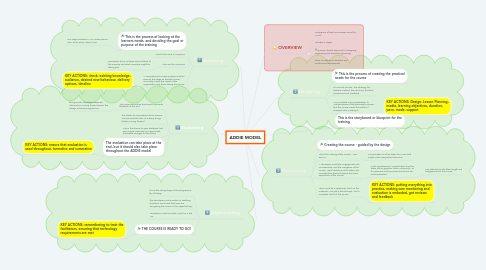
1. Analysing
1.1. This is the process of looking at the learners needs, and deciding the goal or purpose of the training
1.1.1. This stage involved MANY QUESTIONS:: who, what, when, where, how
1.2. What is the Goal or Purpose?
1.3. Who are the Learners?
1.3.1. Remember to be inclusive and not think of the majority, but what minorities might be taking part
1.4. A comprehensive needs analysis must be done at this stage so that the course accurately meets the needs of the organisation and those taking the course.
1.4.1. KEY ACTIONS: check: existing knowledge, audience, desired new behaviour, delivery options, timeline
2. Implementing
2.1. This is the doing stage of the programme - the delivery!
2.2. the developer must monitor for teething problems and check that users are navigating the course in the expected way
2.3. developers could consider a pilot or a test run
2.4. THE COURSE IS READY TO GO!
2.4.1. KEY ACTIONS: remembering to train the facilitators, ensuring that technology requirements are met
3. Evaluating
3.1. The course should be structured to provide feedback at the end
3.1.1. this gives the developer essential information moving forward and in the design of future programmes
3.2. this allows for improvement and revision, and cements the idea of making things better moving forward
3.3. This is the chance to gain feedback, but also should culminate in a report with actionable changes for the future
3.4. The evaluation can take place at the end, but it should also take place throughout the ADDIE model
3.4.1. KEY ACTIONS: ensure that evaluation is used throughout, formative and summative
4. This is the storyboard or blueprint for the training
5. Designing
5.1. This is the process of creating the practical needs for the course
5.2. This would include - the strategy, the delivery method, the structure, duration, assessment and feedback.
5.3. You must take into consideration to Analysis phase of the planning to ensure that the course meets the needs of everyone who is taking it
5.3.1. KEY ACTIONS: Design: Lesson Planning, media, learning objectives, duration, pace, mode, support
6. Developing
6.1. Creating the course - guided by the design
6.2. This is the making of the course - THE DETAIL
6.2.1. consideration must be taken for a user that might make unexpected decisions
6.3. A developer must take engagement into consideration, and the navigation of the course - small details must be taken into consideration that will impact the users experience of the course
6.3.1. In the development, consideration must be taken of the graphics, fonts, colours etc. as this element of the process should not be underestimated
6.3.1.1. pay attention to the flow, length and engagement of the course
6.4. There must be a systematic check of the materials - not just a flick through - but a complete check of the course
6.4.1. KEY ACTIONS: putting everything into practice, making sure monitoring and evaluation is embeded, get reviews and feedback

